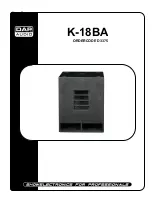
6
Power On
Plug your subwoofer’s AC cord into a wall outlet. Do not use the
outlets on the back of the receiver.
Initially set the Subwoofer-Level Control
¡
to the “min” position.
Turn on your sub by pressing the Power Switch
¶
on the rear panel.
Turn on your entire audio system and start a CD or movie soundtrack
at a moderate level.
Auto On/Standby
With the Power Switch
¶
in the ON position, the LED
§
on the rear
panel will remain lit in red or green to indicate the On/Standby mode
of the subwoofer.
RED = STANDBY (no signal detected, amp off)
GREEN = ON (signal detected, amp on)
The subwoofer will automatically enter the Standby mode after
approximately 10 minutes when no signal is detected from your
system. The subwoofer will then power ON instantly when a signal
is detected. During periods of normal use, the Power Switch
¶
can be left on. You may turn off the Power Switch
¶
for extended
periods of nonoperation, e.g., when you are away on vacation.
Adjust Level
Turn your Subwoofer-Level Control
¡
up to the “5” position
(halfway). If no sound emanates from the subwoofer, check the
AC-line cord and input cables. Are the connectors on the cables
making proper contact? Is the AC plug connected to a “live”
receptacle? Has the Power Switch
¶
been pressed to the “On”
position? Once you have confirmed that the subwoofer is active,
proceed by playing a CD, record or cassette. Use a selection that
has ample bass information.
Set the overall volume control of the preamplifier or stereo to a
comfortable level. Adjust the Subwoofer-Level Control
¡
until
you obtain a pleasing blend of bass. Bass response should not
overpower the room but rather be adjusted so there is a harmonious
blend across the entire musical range. Many users have a tendency
to set the subwoofer volume too loud, adhering to the belief that a
subwoofer is there to produce lots of bass. This is not entirely true.
A subwoofer is there to enhance bass, extending the response of
the entire system so the bass can be felt as well as heard. However,
overall balance must be maintained or the music will not sound
natural. An experienced listener will set the volume of the subwoofer
so its impact on bass response is always there but never obtrusive.
Phase Control
The Phase Switch
£
determines whether the subwoofer speaker’s
piston-like action moves in and out with the main speakers (0˚), or
opposite the main speakers (180˚). Proper phase adjustment depends
on several variables such as room size, subwoofer placement and
listener position. Adjust the phase switch to maximize bass output
at the listening position.
Crossover Adjustments
The Crossover Adjustment Control
™
determines the highest
frequency at which the subwoofer reproduces sounds. If your main
speakers can comfortably reproduce some low-frequency sounds,
set this control to a lower frequency setting, between 50Hz and
100Hz. This will concentrate the subwoofer’s efforts on the ultradeep
bass sounds required by today’s films and music. If you are using
smaller bookshelf speakers that do not extend to the lower bass
frequencies, set the Crossover Adjustment Control to a higher
setting, between 120Hz and 150Hz.
N
NO
OT
TE
E: This control will have no effect if the LFE Input
¢
is used. If
you have a Dolby Digital or DTS processor/receiver, the Low-Pass
Frequency is set by the processor/receiver. Consult your owner’s
manual to learn how to view or change this setting.
OPERATION
BALBOA Sub10.OM.qxd 8/2/06 3:22 PM Page 7


























